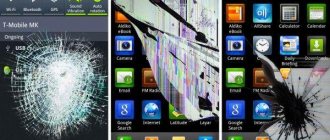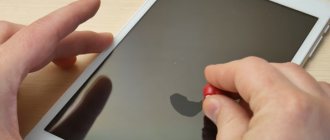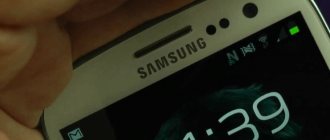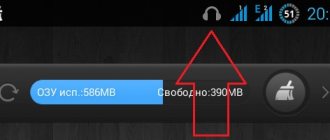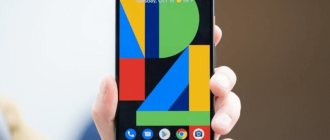Mobile communications have changed a lot over the past 15 years. The speed of mobile Internet has increased, new types of connections have appeared, but the old “herringbone” has not gone away. It indicates the signal level, but not the format.
When you go online on your device, an Internet connection sign appears in the top panel - a letter that indicates the type of connection used. Some standards are used, while others have long been forgotten. What are the differences and advantages of each of the G, E, 3G, H or 4G protocols? What is the h on the phone in the upper right corner? Which protocol is better? Let's figure it out.
G – GPRS (General Packet Radio Service)
This is one of the first Internet protocols for mobile devices. This format allows data transfer at data rates of up to 171.2 Kbps. For that time, this was enough, since most pages were HTML documents without complex animation or multi-level systems.
Also, the sites had almost no advertising (not comparable to what the H format is now), pop-up blocks and notifications. At the same time, smartphones received stable connections and updated basic Internet applications.
What does the 3G, 3.5G 3G+, H and H+ icon mean on a cell phone?
Let's tell you what the mysterious little icons 3G, 3.5G, 3G+, H, H+, L, Lte, VoLTE, VoWIFI mean at the top of your phone or smartphone screen.
In short, this is the type of connection the phone has to the network at a given time.
icons on cell phone screen
The first phones and networks were not able to connect to the Internet at high speed; they were used only for conversations and did not see strange icons, only the number of antenna sticks.
What do the icons on a cell phone mean:
G – the phone is connected to the network (data transfer is enabled) using GPRS technology. One of the first, currently slow, ways to connect to the Internet.
E – connection to the network via EDGE, approximately 3 times faster than G.
3G – Congratulations, your phone is on the 3G network. Depending on the phone model, the icon may appear during data transfer, or constantly signal that the phone is connected to the network in this mode.
If both interlocutors have fairly good phones, with high-quality speakers, and both work on 3G, you can hear with the naked ear that the interlocutor’s voice sounds better and more natural. This is true if the network is not at the launch stage and the phone supports it normally. Otherwise, the quality and stability of the call may not be up to par. The data transfer speed in this mode can reach 384 Kbps, which is already quite bearable for browsing websites or listening to online radio.
As a rule, the phone shows which 3G mode it is operating in
3.5G , 3G+ , H – symbolize the HSDPA connection. Some devices display the 3.5G icon, and H lights up directly when sending or receiving data over the network. Theoretically, speeds of up to 5.7 Mbit/s are possible. You can now download or watch the movie. In practice the speed is lower. For comparison, watching a video in good quality on a phone screen from YouTube, 1 Mbit/s is enough.
H icon on mobile phone screen
H+ is an extension of the previous standard. Similarly, it may not light up all the time, but only when connected, and allows you to achieve speeds of downloading information up to 42.2 MBits/s and transferring information from the subscriber to the network up to 5.76 MBits/s.
LTE , L , 4G – 173 Mbit/s for receiving information from the Internet and 58 Mbit/s for uploading to the network.
VoLTE - (Voice over LTE - voice over LTE). During a call, the voice is transmitted as a data stream over the Internet channel. Provides a wider range of transmitted frequencies compared to a regular voice call (better sound quality). During such a call, data transmission over the Internet is not interrupted.
VoWIFI - (Voice over WI-FI - voice over WI-FI).
The call does not go through base stations, but through the WI-FI network in which you are registered. At the same time, using the phone is no different from usual (no special software is needed, sound quality does not suffer). The cost of calls is according to the home tariff of the cellular operator, even if you are in roaming. For example, abroad and in a place where your operator does not have coverage.
E – EDGE (Enhanced Data Rates for GSM Evolution)
An intermediate type of connection between 2G and 3G. With an Internet speed of 380 Kb/s, it has been popular for a long time. The E standard is almost never used (operators provide it to users who have older smartphone models). A special feature of this format is its high throughput. A stage on the way from GSM to UMTS.
EDGE does not require changing antenna parameters, that is, hardware upgrades. However, the base station subsystem has been modified. This applies to transceivers that supported 8PSK modulation for software updates
.
Mobile devices comply with the stated requirements, code scheme in EDGE, software and modulation. The first phone of this type was released in 2002. It was Nokia 6200.
The evolution of mobile data transmission
Why does the letter E appear on the phone?
But what’s interesting is that there is another situation. Such a letter may appear on the phone, and after it appears, the Internet begins to slow down. Why? It's actually simple:
- Not all areas or areas can receive fast Internet types of 3G and higher.
- Internet reception is especially poor in villages where there are not many cell towers, and the distance to it can be significant. There may even only be GPRS reception, and sometimes even this is difficult.
- Fast Internet may not be available in basements, basements, or underground parking lots. But EDGE can catch, but again, maybe poorly.
Because everything is simple - the phone tries to automatically catch what it can. If it can 3G, it catches it. If it's 4G, it works. And if neither the first nor the second, then he tries EDGE. Of course, it also depends on the smartphone what it supports and what it doesn’t, but it all works something like this.
But it may be that you are in the city and there is no reason to use an EDGE phone, what's the matter then? As a solution, you can try to force change the network type.
How to change network type on Android?
It's actually simple. By the way, if the phone constantly searches for the best type of network, that is, EDGE, 2G, 3G, and so on, then this slightly reduces battery life and the battery discharges a little faster. Therefore, it makes sense to manually set the network type. I’ll also say that if you only talk on the phone, that is, only make calls, you can even choose 2G, this is enough, and the load on the phone will go down a little.
Just open SIM Settings, then select Network Type:
Then select your preferred network type:
To put it very briefly: 4G is a very high-speed Internet, 3G is a regular fast Internet, 2G is ideal for calls, the Internet is a bit slow. Also, with 2G, the sound quality during calls may be slightly lower than when using 4G (but in fact this quality is more than enough).
If the letter E remains on the screen, you can try restarting the mobile Internet. To do this, simply activate airplane mode, and then, after a few minutes, turn it off. This can help. But you can simply restart the phone, which can also have an effect.
LTE - Long Term Evolution
This protocol is a high-speed connection with the best performance parameters. In theory, speeds up to 100 Mb/s.
At this speed, the user can easily download online movies in HD quality through a browser, download or listen to music, or send large files by mail.
Important: LTE is often confused with 4G, a communication standard that supports speeds above 100 Mbit/s. In fact, 4G is a designation for several types of communications in development (LTE Advanced and WiMAX 2), as well as LTE 4G and WiMax.
4G mobile internet connection
The LTE signal (Figure 2) corresponds to the fastest practical 4G technology available today. There are also faster technologies, such as 5G, but these technologies have not yet become widespread.
Rice. 2. LTE signal. The bottom two steps out of four possible are active.
The strength of the signal is shown by a ladder of four steps. Since in Fig. 2, only the two lower steps are active, and not all four, then there is a signal, but it could be better.
H (HSDPA – High Speed Downlink Packet Access)
The h protocol on the phone is a simplified technology based on 3G. Transitional option to fourth generation mobile communications. The signal transmission speed is 14.4 Mbit/s. A feature of this standard is that it borrows a method for increasing data transfer speeds from 2G networks. Thanks to this protocol H, it has become possible to transmit three times more information with one signal.
What is the h standard, and what are its parameters? In a simplified form, it has a data transfer rate of 7.2 Mbit/s.
The technology allowed mobile devices to quickly load websites, download small video and audio files, watch HD movies, and listen to music in different formats.
The main difference between H and H+ is the speed of information transfer, various files, and loading of website pages.
Internet access via 3G or H, H+
The 3G signal (Fig. 3) makes it possible to surf the Internet quite well. Until recently, the presence of a 3G signal made the owner of a gadget (laptop, tablet) literally the “king of the Internet.” It seemed that everything was “flying”. Until... the 4G standard appeared. The same thing awaits us with the arrival of 5G technologies. And we will begin to think about how we used to live without such wonderful quality and speed of mobile Internet!
Rice. 3. 3G signal. All four steps of the four possible signal power ladder are active.
The difference between 3G and 4G (LTE) cannot always be felt and not everywhere. But as soon as the phone (tablet) user wants to work with video information: “chat”, communicate via video communication, watch movies or videos, talk on WhatsApp with the camera on, etc. - then there will be obvious differences between 3G and 4G (LTE) for the worse. For video, it is much better if you have access to the Internet using the 4G (LTE) standard.
Some phones (or tablets) show variations of 3G connectivity. Their screens display not 3G, but H or H+. This is also a format related to the 3G standard (Fig. 4 and Fig. 5).
Rice. 4. H signal, corresponds to 3G connection. Two steps out of four possible are active.
In terms of connection quality and speed, the H signal (Fig. 4) is similar to the 3G signal; this is a 3G connection.
Rice. 5. H+ signal as a 3G connection to the mobile Internet. All four steps of the signal strength ladder are active.
The H+ signal (Fig. 5) belongs to the category of 3G connections. It's better than just H, but worse than LTE or 4G.
Deciphering the icons
It's very simple: the letter designation shows which mobile data transmission technology is currently used. That is, by what technology are you currently connected to the Internet?
Why are they always different? Depending on how well the phone “catch” in a particular place, different data transmission technologies are used. Without your noticing, your phone switches to the one that will provide the best Internet in the given conditions.
Now we will explain in detail what stands behind each letter.
- G - from English. GPRS - General Packet Radio Service, public packet radio communications. This means that you are connected to a 2G or 2.5G mobile network. The maximum connection speed via GPRS is 171.2 Kbps, but in practice it is usually much lower.
- E - from English. EDGE. This is an add-on to GPRS technology that enhances the signal in 2G and 2.5G networks. The maximum speed over EDGE has already reached 474 Kbps, but in practice it is still very slow.
- 3G - from English. third generation - the third generation of GPRS technology, which provides high-speed Internet access. The maximum speed of 3G networks reaches 3.6 Mbit/s.
- H, 3G+, H+ . If you see this icon, you are using HSPA (High Speed Packet Access) technology. It allows you to transfer data over a 3G network at speeds of up to several tens of Mbit/s.
- 4G (LTE, LTE-A) . As can be understood by analogy, this technology got its name from the phrase fourth generation - fourth generation. At the moment, this is the most common mobile Internet technology, the speed of which exceeds 100 Mbit/s when moving and 1 Gbit/s when the smartphone is stationary.

